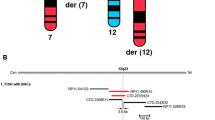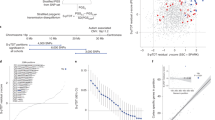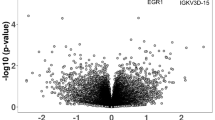Abstract
Asperger syndrome (AS) is a mild form of autistic disorder characterised by impairment in social interaction as well as a restricted pattern of behaviour, interests, and activities. Two patients with AS and balanced translocations t(13;17) and t(17;19), respectively, were identified. Fluorescent in situ hybridisation (FISH) analysis with chromosome 17 specific clones to metaphase chromosomes from both patients showed that the chromosome 17 breakpoints are located within a 300 kb region at 17p13. The region spans 14 known genes. The expression of these genes was analysed in lymphoblastoid RNA derived from the patients and healthy control individuals. The CHRNE, DKFZP566H073, LOC90048, PFN1, SPAG7, KIAA0909, ZNF232 and KIF1C genes showed similar levels of expression in cell lines with the translocations when compared with cell lines with normal karyotype. No expression was detected for the MINK, GP1BA, SLC25A11, ENO3, FLJ10060 and USP6 genes in any of the cell lines. The close physical relation of the two 17p breakpoints suggest a common genetic aetiology for the phenotype in the patients. Structural and functional analysis of the genes located around the two 17p breakpoints in t(13;17) and t(17;19) patients may reveal candidate sequences for the AS phenotype.
Similar content being viewed by others
Log in or create a free account to read this content
Gain free access to this article, as well as selected content from this journal and more on nature.com
or
References
Gillberg, C & Billstedt, E : Autism and Asperger syndrome coexistence with other clinical disorders. Acta Psychiatr Scand, (2000). 102, 321–330.
Lamb, JA, Moore, J, Bailey, A & Monaco, AP : Austism: recent molecular genetic advances. Hum Mol Genet, (2000). 9, 861–868.
Folstein, SE & Rosen-Sheidley, B : Genetics of autism: complex aetiology for a heterogeneous disorder. Nat Rev Genet, (2001). 2, 943–955.
International Molecular Genetic Study of Autism Consortium : A full genome screen for autism with evidence for linkage to a region on chromosome 7q. Hum Mol Genet, (1998). 7, 571–578.
Collaborative Linkage Study of Autism : An autosomal genomic screen for autism. Am J Med Genet, (1999). 88, 609–615.
Philippe, A, Martinez, M & Guilloud-Bataille, M et al : Genome-wide scan for autism susceptibility genes. Paris Autism Research International Sibpair Study. Hum Mol Genet, (1999). 8, 805–812.
Risch, N, Spiker, D & Lotspeich, L et al : A genomic screen of autism: evidence for a multilocus etiology. Am J Med Genet, (1999). 65, 493–507.
Liu, J, Nyholt, DR & Magnussen, P et al : A genomewide screen for autism susceptibility loci. Am J Hum Genet, (2001). 69, 327–340.
Buxbaum, JD, Silverman, JM & Smith, CJ et al : Evidence for a susceptibility gene for autism on chromosome 2 and for genetic heterogeneity. Am J Hum Genet, (2001). 68, 1514–1520.
International Molecular Genetic Study of Autism Consortium : A genomewide screen for autism: strong evidence for linkage to chromosomes 2q, 7q, and 16p. Am J Hum Genet, (2001). 69, 570–581.
Alarcon, M, Cantor, RM, Liu, J, Gilliam, TC & Geschwind, DH Autism Genetic Research Exchange Consortium: Evidence for a language quantitative trait locus on chromosome 7q in multiplex autism families. Am J Hum Genet, (2002). 70, 60–71.
Vincent, JB, Herbrick, JA, Gurling, HMD, Bolton, PF, Roberts, W & Scherer, SW : Identification of a novel gene on chromosome 7q31 that is interrupted by a translocation breakpoint in an autistic individual. Am J Hum Genet, (2000). 67, 510–514.
Tentler, D, Brandberg, G & Betancur, C et al : A balanced reciprocal translocation t(5;7)(q14;q32) associated with autistic disorder: Molecular analysis of the chromosome 7 breakpoint. Am J Med Genet (Neuropsychiatr Genet), (2001). 105, 729–736.
Maestrini, E, Lai, C & Marlow, A et al : Serotonin transporter (5-HTT) and γ-aminobutyric acid receptor subunit β3 (GABRB3) gene polymorphisms are not associated with autism in the IMGSA families. Am J Med Genet (Neuropsychiatr Genet), (1999). 88, 492–496.
Salmon, B, Hallmayer, J & Rogers, T et al : Absence of linkage disequilibrium to chromosome 15q11-q13 markers in 139 multiplex families with autism. Am J Med Genet (Neuropsychiatr Genet), (1999). 88, 551–556.
Gillberg, C : Clinical and neurological aspects of Asperger syndrome in six family studies. in Frith U (ed)Austism and Asperger syndrome, Cambridge University Press (1991). pp122–146.
Gillberg, C, Gillberg, C, Rastam, M & Wentz, E : The Asperger Syndrome (and high-functioning autism) Diagnostic Interview (ASDI): a preliminary study of a new structured clinical interview. Autism, (2001). 5, 57–66.
Lord, C, Rutter, M & Le Couteur, A : Autism Diagnostic Interview-revised: a revised version of a diagnostic interview for caregivers of individuals with possible pervasive developmental disorders. J Autism Dev Disord, (1994). 24, 659–685.
Anneren, G, Dahl, N, Uddenfeldt, U & Janols, LO : Asperger syndrome in a boy with a balanced de novo translocation: t(17;19) (p13.3;p11). Am J Med Genet, (1995). 56, 330–331.
Lichter, P, Cremer, T, Borden, J, Manuelidis, L & Ward, DC : Delineation of individual human chromosomes in metaphase and interphase cells by in situ suppression hybridization using recombinant DNA libraries. Hum Genet, (1988). 80, 224–234.
Pinkel, D, Straume, T & Gray, JW : Cytogenetic analysis using quantitative, high-sensitivity, fluorescence in situ hybridization. Proc Natl Acad Sci USA, (1986). 83, 2934–2938.
Albertsen, H, Thliveris, A, Riley, JH, Munroe, DJ, Watkins, P & Basson, CT : Isolating total DNA from YAC-bearing yeast by spheroplast method. in Dracopoli NC, Haines JL, Korf BR, et al (eds)Current Protocols in Human Genetics, Wiley and Sons Inc., New York (1998). pp5 9 27–28.
Sambrook, J, Fritsch, EF & Maniatis, T Molecular cloning: a laboratory manual, 2nd edn Cold Spring Harbor: Cold Spring Harbor Laboratory Press 1989
Barbu, V & Dautry, F : Northern blot normalization with 28S oligonucleotide probe. Nucleic Acids Res, (1989). 17, 7115
Dan, I, Watanabe, NM & Kobayashi, T et al : Molecular cloning of MINK, a novel member of mammalian GCK family kinases, which is up-regulated during postnatal mouse cerebral development. FEBS Lett, (2000). 469, 19–23.
Beeson, D, Brydson, M & Betty, M et al : Primary structure of the human muscle acetylcholine receptor. cDNA cloning of the gamma and epsilon subunits. Eur J Biochem, (1993). 215, 229–238.
Lopez, JA, Chung, DW, Fujikawa, K, Hagen, FS, Papayannopoulou, T & Roth, GJ : Cloning of the alpha chain of human platelet glycoprotein Ib: a transmembrane protein with homology to leucine-rich alpha 2-glycoprotein. Proc Natl Acad Sci USA, (1987). 84, 5615–5619.
Piccininni, S, Iacobazzi, V, Lauria, G, Rocchi, M & Palmieri, F : Assignment of the oxoglutarate carrier gene (SLC20A4) to human chromosome 17p13.3. Cytogenet Cell Genet, (1998). 83, 256–257.
Witke, W, Sutherland, JD, Sharpe, A, Arai, M & Kwiatkowski, DJ : Profilin I is essential for cell survival and cell division in early mouse development. Proc Natl Acad Sci USA, (2001). 98, 3832–3836.
Peshavaria, M & Day, IN : Molecular structure of the human muscle-specific enolase gene (ENO3). Biochem J, (1991). 275, 427–433.
Zhang, QH, Ye, M & Wu, XY et al : Cloning functional analysis of cDNAs with open reading frames for 300 previously undefined genes expressed in CD34+ hematopoietic stem/progenitor cells. Genome Res, (2000). 10, 1546–1560.
Dorner, C, Ciossek, T, Muller, S, Moller, PH, Ullrich, A & Lammers, R : Characterization of KIF1C, a new kinesin-like protein involved in vesicle transport from the Golgi apparatus to the endoplasmic reticulum. J Biol Chem, (1998). 273, 20267–20275.
Mavrogiannis, LA, Argyrokastritis, A & Tzitzikas, N et al : ZNF232: structure and expression analysis of a novel human C(2)H(2) zinc finger gene, member of the SCAN/LeR domain subfamily. Biochim Biophys Acta, (2001). 1518, 300–305.
Nakamura, T, Hillova, J & Mariage-Samson, R et al : A novel transcriptional unit of the tre oncogene widely expressed in human cancer cells. Oncogene, (1992). 7, 733–741.
Acknowledgements
We thank Dr Nils-Erik Heldin and Dr Taras Stasyk for advice and technical assistance. This work was supported by grants from the Swedish Medical Research Council, Childrens Cancer Foundation of Sweden, the Swedish Cancer Society, the Söderström-Königska Foundation and the Swedish Medical Society, The Sävstaholm Society, Torsten and Ragnar Söderbergs Fund, The Lundbeck Foundation, the Borgström Foundation, and The Wilhelm and Martina Lundbergs Foundation.
Author information
Authors and Affiliations
Corresponding author
Rights and permissions
About this article
Cite this article
Tentler, D., Johannesson, T., Johansson, M. et al. A candidate region for Asperger syndrome defined by two 17p breakpoints. Eur J Hum Genet 11, 189–195 (2003). https://doi.org/10.1038/sj.ejhg.5200939
Received:
Revised:
Accepted:
Published:
Issue date:
DOI: https://doi.org/10.1038/sj.ejhg.5200939
Keywords
This article is cited by
-
Expression of SPAG7 and its regulatory microRNAs in seminal plasma and seminal plasma-derived extracellular vesicles of patients with subfertility
Scientific Reports (2023)
-
Characterization of novel USP6 gene rearrangements in a subset of so-called cellular fibroma of tendon sheath
Modern Pathology (2021)
-
3p22.1p21.31 microdeletion identifies CCK as Asperger syndrome candidate gene and shows the way for therapeutic strategies in chromosome imbalances
Molecular Cytogenetics (2015)
-
Asperger syndrome
European Child & Adolescent Psychiatry (2009)
-
Evidence for involvement of TRE-2 (USP6) oncogene, low-copy repeat and acrocentric heterochromatin in two families with chromosomal translocations
Human Genetics (2006)



